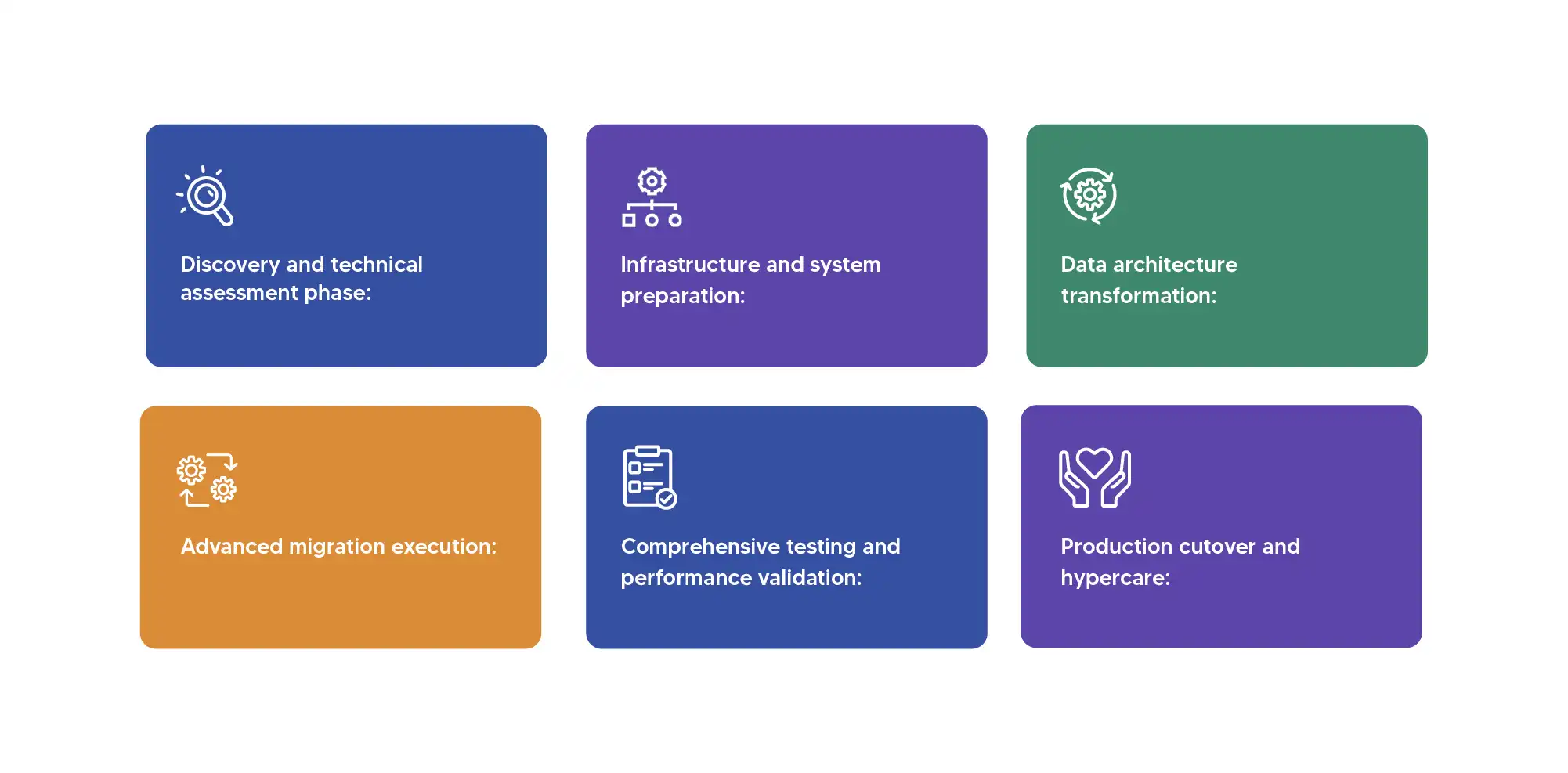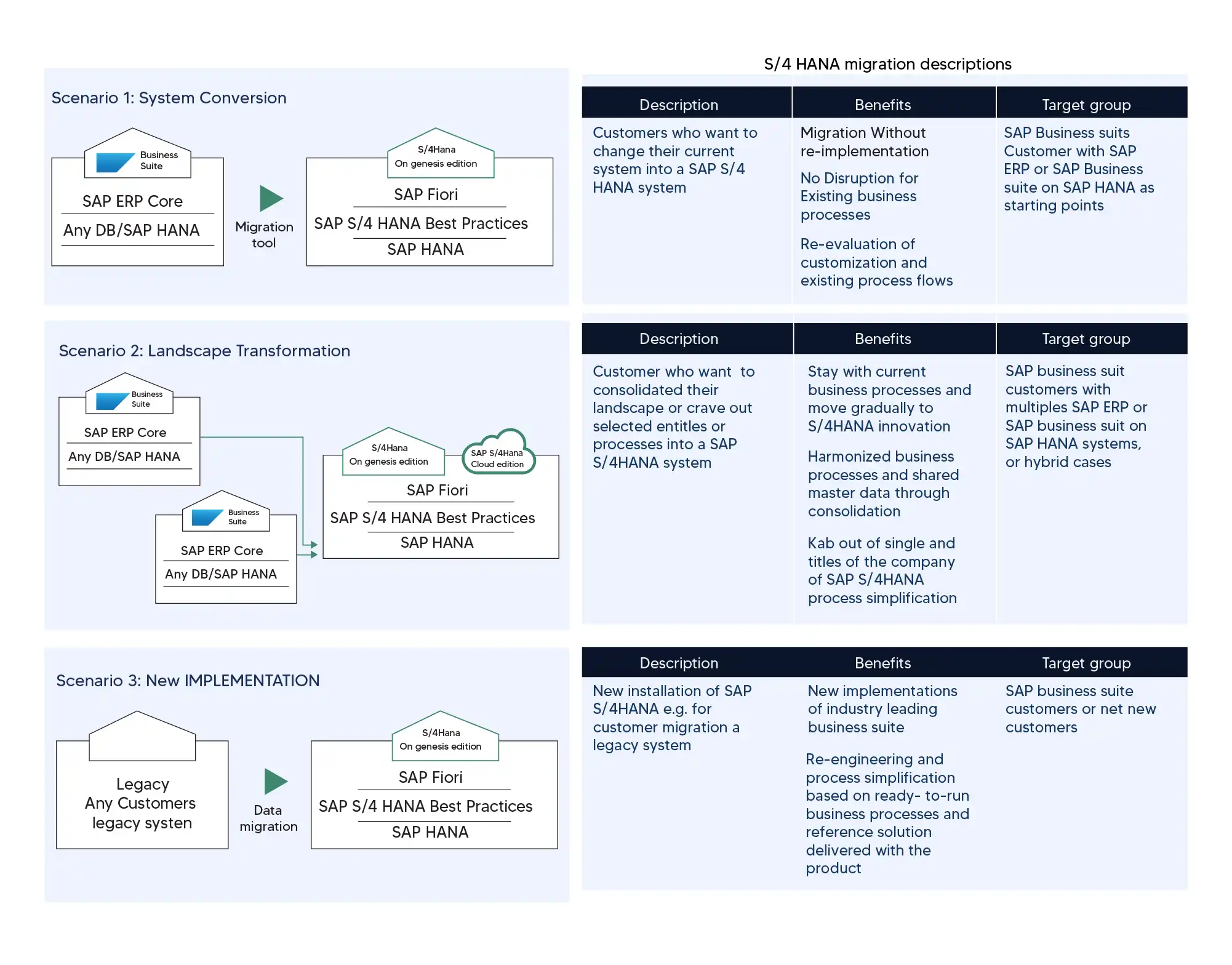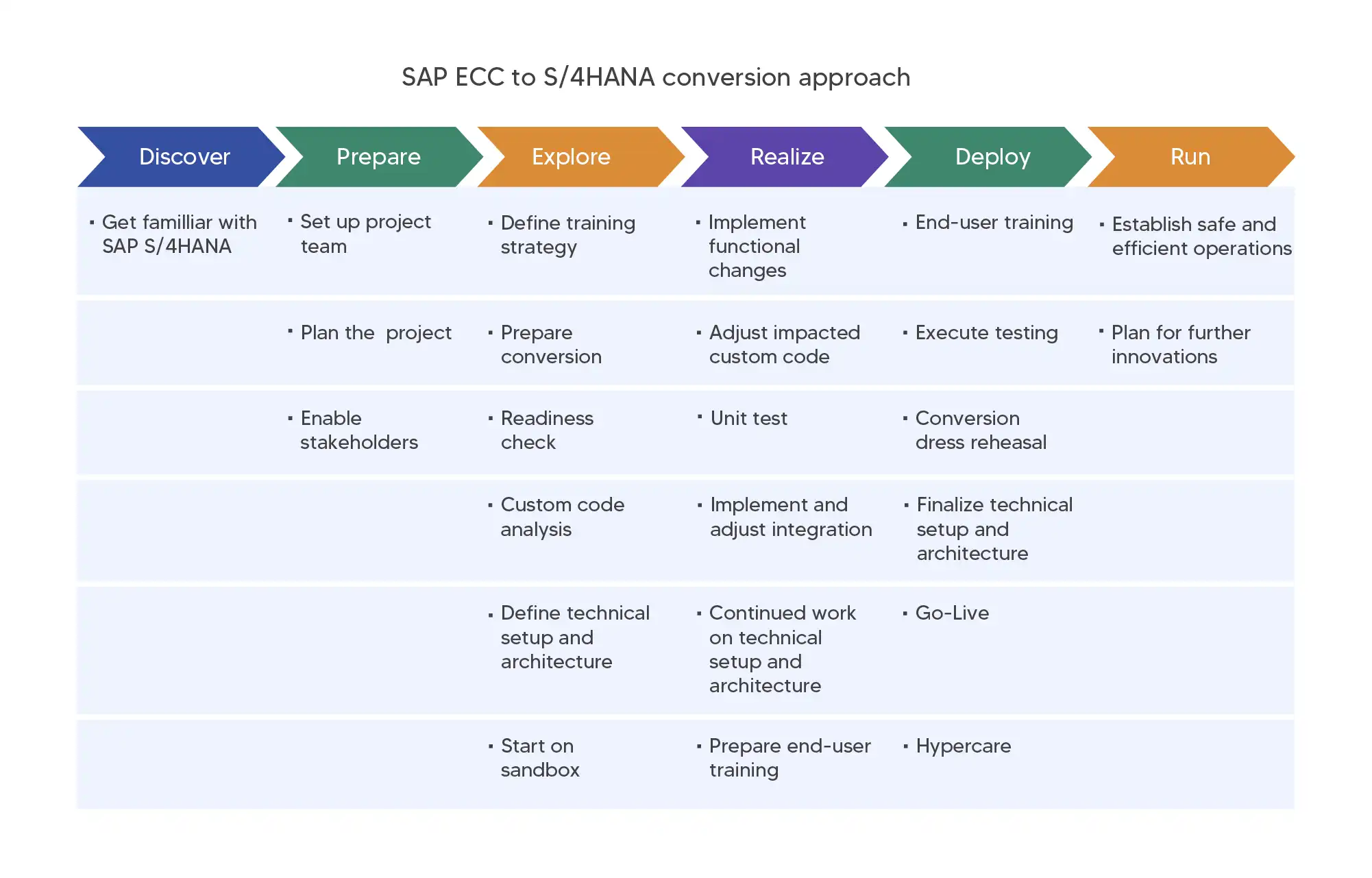Other recent blogs
Let's talk
Reach out, we'd love to hear from you!
With SAP ECC's end-of-support deadline ticking faster, millions of CEOs are under constant pressure to make a critical ERP transformation decision that could make or break their operational future. Is SAP ECC obsolete? Yes, the mainstream maintenance for legacy SAP ECC systems will no longer be available after December 31, 2027.
Despite the urgency, surprisingly, only 37% of SAP ECC customers have licensed S/4HANA as of now. Many CEOs believe moving from ECC to S/4HANA is more than a technology change. However, here’s the brutal reality: missing this important ERP migration may result in budget overruns, extended timelines, and business disruptions—something many business leaders are unable to see.
Another hurdle stopping companies from this SAP migration from ECC to S/4 Hana is inadequate preparation. Many intelligent enterprises, during their SAP-centric ERP transformation journey, often discover that what seemed like a straightforward technical upgrade has evolved into a complex organizational metamorphosis due to a lack of proper strategic foresight, meticulous planning, and unwavering commitment.
Before diving into the ECC to S4/Hana migration challenges that can derail your migration, it's very crucial to get a quick look at what you're actually migrating to and why the transition is so fundamentally different from previous SAP upgrades.
SAP ECC to S/4HANA Migration: The path forward to enterprise intelligence explained
SAP S/4HANA cannot be referred to as just another evolution of ECC. This is a complete reimagining of Enterprise Resource Planning (ERP) strongly pillared on the SAP HANA in-memory database. When companies approach this SAP-centered ERP transformation, they must be prepared for both unprecedented opportunities and complex challenges that require a different approach altogether.
But how is SAP ECC different from SAP S/4HANA? SAP ECC continues to run actively on classical databases; it heavily depends only on batch processing and complicated data schemes. SAP S/4HANA, on the other hand, is deployed on HANA in-memory database, which has received active security in making real-time analytics and simplified data models.
Here’s a closer look at a comprehensive comparison: SAP ECC vs S/4HANA
.webp)
When the workflows and critical business data of legacy systems moved to SAP S/4HANA from SAP ECC, the entire migrating journey sets the organization in a competitive position with numerous benefits. Firstly, the in-memory database helps unlock real-time analytics - an essential component in a strategic decision-making roadmap. Business leaders can leverage the insights to bring significant improvements in their SAP ecosystem’s organizational agility over traditional batch processing.
Secondly, the clean and streamlined S/4HANA architecture is easily accessible via a unified platform, which is compliant for both transactional and analytical workloads. This helps companies manage system complexity and total ownership costs by simplifying the data model, reducing redundancies, and focusing on standard ERP functionalities. Thirdly, the intelligent SAP S/4HANA's cloud readiness marks a fundamental shift from the traditional SAP ECC architecture by offering seamless support for both transactional and analytical workloads. This removes the need for setting up separate databases for numerous requirements and improves cloud performance.
Additionally, SAP S/4HANA is flexible in various deployment models: on-premise, public cloud, private cloud, hosted cloud, and hybrid environments. And how can we ignore SAP HANA's intelligent capabilities due to Artificial Intelligence (AI) and Machine Learning (ML) integration powered by the Predictive Analysis Library (PAL) and Automated Predictive Library (APL)? Internet of Things (IoT) is another benefit of S/4HANA over ECC. Companies can seamlessly connect to IoT devices (sensors, machines, wearables) to ingest real-time data streams into the S/4HANA system and leverage real-time data monitoring and analysis.
What are the steps of data migration from ECC to S/4HANA?

The data migration process involves a sophisticated multi-phase approach that requires deep technical expertise and methodical execution:
- Discovery and technical assessment phase:
This critical first step in the sap migration from ECC to S4/Hana and the process starts with running SAP Readiness Check tool followed by Custom Code Analysis (using ABAP Test Cockpit), and Simplification Item Check. It is important in order to identify the gaps like incompatible customizations and modifications.
When SAP teams run a comprehensive analysis to system landscape analysis, it is obvious to check RFC connections, interfaces, batch jobs, and user exits. The next important step is database sizing analysis that helps SAP teams to determines HANA memory requirements. During this step, teams often able to find 30-50% data reduction potential through elimination of aggregate tables and index structures inherent in traditional RDBMS systems. - Infrastructure and system preparation:
Infrastructure provisioning focuses on HANA-specific requirements, including column-store optimization and in-memory computing capabilities. System preparation involves installing SAP S/4HANA Foundation, configuring system parameters for optimal HANA performance, and establishing development, quality, and production landscapes. Technical teams implement SAP Transport Management System (TMS) configuration and establish connection frameworks for System Landscape Directory (SLD) integration. - Data architecture transformation:
This phase involves complex data model conversion from ECC's traditional row-based tables to S/4HANA's simplified schema. Key activities include eliminating redundant aggregate tables (like those used in CO-PA), converting material ledger structures, and implementing Universal Journal for real-time financial reporting.
Data architects utilize SAP's Data Migration Cockpit and Migration Object Modeler to create custom migration objects for business-specific data structures that don't have standard conversion paths. - Advanced migration execution:
Migration execution leverages SAP Software Update Manager (SUM) with Database Migration Option (DMO) for brownfield conversions, or SAP S/4HANA Migration Cockpit for selective data transfer in greenfield scenarios.
Technical teams execute pre-conversion activities including archive development, implement delta conversion for large datasets, and utilize SAP HANA's parallel processing capabilities to optimize migration performance. Custom ABAP programs handle complex business logic transformations that cannot be addressed through standard conversion tools. - Comprehensive testing and performance validation:
Testing encompasses multiple layers including data consistency validation through SAP's standard reconciliation reports, performance testing using SAP LoadRunner or similar tools to verify in-memory processing improvements, and business process validation through end-to-end scenario testing.
Technical validation includes checking statistical performance indicators, validating custom code performance in the HANA environment, and ensuring integration point functionality with external systems. - Production cutover and hypercare:
The final phase involves coordinated cutover activities with minimal downtime strategies, often utilizing SAP's Near Zero Downtime (NZDT) techniques for large-scale implementations.
Post-migration activities include system monitoring using SAP Solution Manager, performance optimization through HANA Studio analysis, and establishing ongoing support processes for the transformed S/4HANA environment.
Hypercare support typically extends 4-6 weeks post-go-live, focusing on system stability, user support, and performance optimization.
Moving from SAP ECC to S/4HANA: Revealing major 4 challenges
Despite the compelling business case for migration, organizations consistently encounter four major challenges that can transform their digital transformation journey into a costly nightmare:

Challenge 1: Customization complexity and technical debt
The biggest shock for most organizations comes from discovering the extent of their technical debt. Years of ECC customizations, modifications, and workarounds that seemed logical in isolation now represent a complex web of dependencies that must be untangled before migration can proceed.
S/4HANA's "clean core" philosophy requires organizations to either eliminate customizations entirely or rebuild them using modern extension frameworks. This often means fundamental changes to business processes that have been embedded in the organization for years.
Challenge 2: Data quality and volume management
ECC systems typically accumulate vast amounts of data over decades of operation, much of it redundant, outdated, or corrupted. The migration to S/4HANA's streamlined data model exposes these quality issues in ways that can halt the entire project.
Organizations frequently underestimate the time and resources required for data cleansing, archiving, and transformation. What appears to be a straightforward data transfer becomes a months-long process of data archaeology and remediation.
Challenge 3: Change management and user adoption
The transition from familiar ECC interfaces to S/4HANA's modern Fiori environment represents more than a cosmetic change—it's a fundamental shift in how users interact with their core business systems.
These companies learned the hard way that SAP S/4HANA migration is far more than just a technical upgrade – it's a business transformation that requires comprehensive change management strategies. Without proper user preparation and support, even technically successful migrations can fail due to user resistance and productivity losses.
Challenge 4: Integration ecosystem disruption
Most ECC implementations are supported by complex ecosystems of third-party applications, custom interfaces, and middleware solutions. The migration to S/4HANA often breaks these connections, requiring extensive rework of integration points.
Organizations must evaluate every connection point, API, and data feed to ensure compatibility with S/4HANA's new architecture. This integration challenge extends beyond technical considerations to include vendor relationships, licensing agreements, and support contracts.
SAP ECC to S/4HANA Migration: Preparation steps to avoid the SAP implementation challenges

Success in S/4HANA migration isn't about avoiding challenges—it's about systematically preparing for them. To avoid common SAP implementation challenges during ECC to S/4HANA migration, organizations must begin with a comprehensive discovery and assessment of their current environment, including all customizations, integrations, data volumes, and quality issues.
Using automated tools to identify code incompatibilities and prioritize remediation efforts helps prevent technical roadblocks later in the process. Equally critical is selecting the appropriate migration approach—whether Greenfield, Brownfield, or Bluefield—based on organizational circumstances, timeline constraints, and transformation goals, as this strategic decision directly impacts project complexity and potential implementation pitfalls.
For risk mitigation, early change management initiatives and thorough technical preparation are the most effective ways to prevent SAP implementation challenges. Starting change management activities early in the project lifecycle, including comprehensive training programs and user champion networks, addresses the human factor that often derails SAP projects.
Simultaneously, proactive integration planning that maps all connection points and leverages S/4HANA's API-first approach, combined with rigorous iterative testing frameworks and multiple migration rehearsals, ensures technical stability and identifies potential issues before they become costly go-live problems. This dual focus on people and process preparation significantly reduces the risk of common implementation failures.
Converting SAP ECC to SAP S/4HANA: Which requirements must be met before?
Understanding the critical prerequisites and migration scenarios forms the foundation for successful S/4HANA transformation. Each migration path presents unique requirements and considerations that must be thoroughly evaluated. The first requirement is Migration Scenario Selection and Infrastructure Alignment to make sure organization choose correctly between three primary migration scenarios—Greenfield (new implementation), Brownfield (system conversion), or Bluefield (selective data transition) as each demands specific infrastructure configurations.
Next in the process comes Advanced Software Compatibility and Code Assessment, which stands firmly beyond basic third-party compatibility. When an organization conducts a comprehensive impact analysis by using SAP's Simplification Database and Custom Code Migration tools, the team is able to identify many critical aspects such as
- obsolete transactions with no S/4HANA equivalent
- enhancement framework modifications that may conflict with clean core principles
- integration middleware compatibility with S/4HANA's OData and REST API architecture
If any of these challenges are ignored, the SAP implementation lifecycle intensifies with legacy bolt-on solutions and custom developments, which further results in the urgency of complete redesign or replacement.
Strategic Data Architecture and Lifecycle Management are the third most important requirements when moving from SAP ECC to S/4HANA. It is imperative to understand that S/4HANA's simplified data model requires strategic decisions about data retention, archival policies, and master data governance.
So, when organizations fail to implement data lifecycle management strategies, they struggle to utilize SAP's Information Lifecycle Management (ILM) for historical data archiving while dealing with problems associated with compliance with regulatory retention requirements. Data preparation extends beyond cleansing to include harmonization of duplicate master data records, standardization of organizational structures, and alignment of chart of accounts across multiple company codes.
How Kellton streamlines SAP ERP migration journey?
As a certified SAP implementation services partner, Kellton transforms the demanding ECC to S/4HANA migration journey into a strategic advantage through a comprehensive risk-mitigated approach that addresses each of the four major challenges head-on.

- Discover through strategic assessment and planning:
Kellton begins every migration with an in-depth assessment of your current ECC environment, business processes, and strategic objectives. This analysis forms the foundation for selecting the optimal migration strategy—whether Greenfield, Brownfield, or Bluefield—that aligns with your organization's unique circumstances and transformation goals. - Prepare for technical excellence:
With deep expertise in both legacy ECC systems and cutting-edge S/4HANA capabilities, Kellton's technical teams navigate the complex landscape of customization remediation, data migration, and system integration. Our proven methodologies ensure that technical debt is addressed systematically while preserving critical business functionality. - Explore and realize change management possibilities:
Understanding that successful migration extends far beyond technical implementation, Kellton provides comprehensive change management services that prepare your organization for the cultural and operational shifts required by S/4HANA. Our approach includes stakeholder engagement, training program development, and ongoing support to ensure user adoption and business value realization. - Deploy end-to-end project execution:
From initial planning through post-go-live optimization, Kellton manages the entire migration lifecycle with proven project management methodologies, risk mitigation strategies, and quality assurance processes. Our teams work alongside your organization to ensure minimal business disruption while maximizing the transformational benefits of S/4HANA. - Value realization focus:
Beyond technical migration, Kellton emphasizes aligning S/4HANA's advanced capabilities with your organizational objectives. We help you leverage real-time analytics, streamlined processes, and modern user experiences to drive measurable business improvements and competitive advantages.
The question isn't whether you'll migrate to S/4HANA—it's whether you'll be prepared for the journey ahead. Those who start planning now, with the right partner and the right approach, will find themselves not just surviving the transition, but thriving in the new landscape of possibilities that S/4HANA creates.






